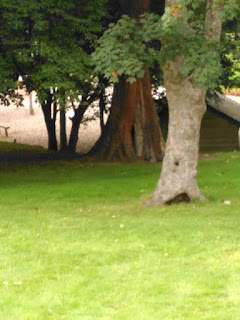Letter from Barry & Vale Friends of the Earth to Erica Dixon, Biodiversity officer VoG Council
Trees at Headlands School covered by the TPO 2010
Proposed: Horse chestnut-fell, 2x Sycamores-fell, Sycamore-fell Holm Oak-fell, Cherry-fell, Cherry-fell, Sycamore-fell, Ash-remove snapped limb, Sycamore-fell
I understand you were asked last week to give a view on this application so I left ansa-phone requests to discuss it, but you haven't returned my calls.
We believe this summary (to fell 9 trees and work on the Ash) is misleading - the application is for work on over 50 trees and groups which are covered by the group designations in the TPO.
We would ask you to assess the whole of this proposed work. It appears to be designed to manage the trees as individuals, rather than manage them as maturing woodland, where rotten hollows and rotten branches provide habitat for a richer woodland ecosystem. Their proposed management method would impoverish the biodiversity, so you might judge it's not necessary or appropriate.
 |
| 19 trees to be felled or crowned 9 with TPOs at Headlands School as part of development plans by children’s charity Action for Children |
Second, the wholesale felling, crown raising etc. can have
a) landscape effects, detracting from this mature 'parkland'
b) impacts on the bats that regularly forage on this site, removing their roosting places and even hibernation holes.
 |
| A rare Wellingtonia that could be chopped |
Third, the removal of trees (sycamores) along the edge of the cliff would impact on the wider landscape views - of Penarth headland from the sea and the Pier. Since there are TPOs on these trees and no demonstrated urgent need to cut short their lives for being assessed as in poor condition, replacement trees could be planted now and the TPO trees kept for a further ~10 years until the replacements are well grown. The replacement species need not all be sycamores, but some hardier and longer-lived ones.
An obvious point is that the aboriculture report supplied in support of the full (>50 trees) application is now a year old - it cannot support 'urgent' works on 'dangerous' trees - fails to recognise the group TPOs (or the individual TPOs) and fails to supply information for the Council's duty under the Habitats/species Regs. Since your TPO officer's intention is to require replacement trees to be planted, a new application should include this planting and name replacement species, with the purpose of enriching the parkland/woodland ecology.
We'd like your report to address these landscape and ecology issues and would be keen to exchange further information from local knowledge.
More information here You can still put an objection in here
More information here You can still put an objection in here
It may not be the tallest tree in the world but Sequoiadendron giganteum is the largest by volume, reaching up to 95 m in height and 12 m in diameter. On its introduction to Britain in 1853, the species was named Wellingtonia gigantea after the recently deceased Duke of Wellington. However, this scientific name was not legitimate because the name Wellingtonia had been used earlier for another plant (although it is still called Wellingtonia as a common name in the UK).
No comments:
Post a Comment